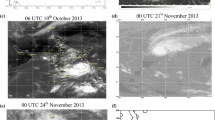Abstract
The initial condition accuracy is a major concern for tropical cyclone (TC) numerical forecast. The ensemble-based data assimilation techniques have shown great promise to initialize TC forecast. In addition to initial condition uncertainty, representing model errors (e.g. physics deficiencies) is another important issue in an ensemble forecasting system. To improve TC prediction from both deterministic and probabilistic standpoints, a Typhoon Ensemble Data Assimilation and Prediction System (TEDAPS) using an ensemble-based data assimilation scheme and a multi-physics approach based on Weather Research and Forecasting (WRF) model, has been developed in Shanghai Typhoon Institute and running realtime since 2015. Performance of TEDAPS in the prediction of track, intensity and associated disaster has been evaluated for the Western North Pacific TCs in the years of 2015–2018, and compared against the NCEP GEFS.
TEDAPS produces markedly better intensity forecast by effectively reducing the weak biases and therefore the degree of underdispersion compared to GEFS. The errors of TEDAPS track forecasts are comparative with (slightly worse than) those of GEFS at longer (shorter) forecast leads. TEDAPS ensemble-mean exhibits advantage over deterministic forecast in track forecasts at long lead times, whereas this superiority is limited to typhoon or weaker TCs in intensity forecasts due to systematical underestimation. Four case-studies for three landfalling cyclones and one recurving cyclone demonstrate the capacities of TEDAPS in predicting some challenging TCs, as well as in capturing the forecast uncertainty and the potential threat from TC-associated hazards.
Similar content being viewed by others
References
Aberson S D, Aksoy A, Sellwood K J, Vukicevic T, Zhang X (2015). Assimilation of high-resolution tropical cyclone observations with an ensemble Kalman filter using NOAA/AOML/HRD’s HEDAS: evaluation of the 2008–11 HWRF forecasts. Mon Weather Rev, 143(2): 511–523
Cavallo S M, Torn R D, Snyder C, Davis C, Wang W, Done J (2013). Evaluation of the advanced hurricane WRF data assimilation system for the 2009 Atlantic hurricane season. Mon Weather Rev, 141(2): 523–541
Hamill T M, Whitaker J S, Fiorino M, Benjamin S J (2011). Global ensemble predictions of 2009’s tropical cyclones initialized with an ensemble Kalman filter. Mon Weather Rev, 139(2): 668–688
Hou D, Toth Z, Zhu Y, Yang W (2008). Impact of a stochastic perturbation scheme on global ensemble forecast. In: 19th AMS conference on probability and statistics, New Orleans, Louisiana
Li H, Luo J, Chen B (2015). Assimilation of real observational data with the GSI-based hybrid data assimilation system to improve typhoon forecast. J Trop Meteorol, 21(4): 400–407
Luo J, Chen B, Li H, Fan G Z, Wang X F (2013). Typhoon track forecast with a hybrid GSI-ETKF data assimilation system. Atmos Ocean Sci Lett, 6(3): 161–166
Nakamura J, Lall U, Kushnir Y, Rajagopalan B (2015). (2105). HITS: hurricane intensity and track simulator with North Atlantic Ocean applications for risk assessment. J Appl Meteorol Climatol, 54(7): 1620–1636
Peng S, Qian Y K, Lai Z, Hao S, Chen S, Xu H, Wang D, Xu X, Chan J C, Zhou H, Liu D (2015). On the mechanisms of the recurvature of Super Typhoon Megi. Sci Rep, 4(1): 4451
Shen Y, Zhao P, Pan Y, Yu J (2014). A high spatiotemporal gauge-satellite merged precipitation analysis over China. J Geophys Res D Atmospheres, 119(6): 3063–3075
Torn R D (2010). Performance of a mesoscale ensemble Kalman filter (EnKF) during the NOAA high-resolution hurricane test. Mon Weather Rev, 138(12): 4375–4392
Wang X (2010). Incorporating ensemble covariance in the Gridpoint Statistical Interpolation (GSI) variational minimization: a mathematical framework. Mon Weather Rev, 138(7): 2990–2995
Wang X (2011). Application of the WRF hybrid ETKF-3DVAR data assimilation system for hurricane track forecasts. Weather Forecast, 26(6): 868–884
Yang S C, Kalnay E, Miyoshi T (2012). Accelerating the EnKF Spinup for typhoon assimilation and prediction. Weather Forecast, 27(4): 878–897
Ying M, Zhang W, Yu H, Lu X, Feng J, Fan Y, Zhu Y, Chen D (2014). An overview of the China Meteorological Administration tropical cyclone database. J Atmos Ocean Technol, 31(2): 287–301
Yu Z, Yu H, Chen P, Qian C, Yue C (2009). Verification of tropical cyclone-related satellite precipitation estimates in Mainland China. J Appl Meteorol Climatol, 48(11): 2227–2241
Zhang F, Weng Y, Sippel J A, Meng Z, Bishop C H (2009). Cloud-resolving hurricane initialization and prediction through assimilation of Doppler radar observations with an ensemble Kalman filter: Humberto (2007). Mon Weather Rev, 137(7): 2105–2125
Zhang F, Weng Y (2015). Predicting hurricane intensity and associated hazards: a five-year real-time forecast experiment with assimilation of airborne doppler radar observations. Bull Am Meteorol Soc, 96(1): 25–33
Zhang X, Quirino T, Yeh K S, Gopalakrishnan S, Marks F, Goldenberg S, Aberson S (2011). HWRFx: improving hurricane forecasts with high-resolution modeling. Comput Sci Eng, 13(1): 13–21
Acknowledgements
The authors would like to thank Dr. Lina Bai in STI for providing the best-track data. This research was primarily supported by National Key R&D Program of China (Grant No. 2018YFC1506404), the National Basic Research Program of China (Grant No. 2015CB452806), National Natural Science Foundation of China (Grant No. 41575107), and in part by Shanghai Sailing Program (Grant No. 19YF1458700), Scientific Research Program of Shanghai Science & Technology Commission (Grant No. 19dz1200101), National Programme on Global Change and Air-Sea Interaction (Grant No. GASI-IPOVAI-04), and Shanghai Typhoon Innovation Team grants to Shanghai Typhoon Institute.
Author information
Authors and Affiliations
Corresponding author
Rights and permissions
About this article
Cite this article
Li, H., Luo, J. & Xu, M. Ensemble data assimilation and prediction of typhoon and associated hazards using TEDAPS: evaluation for 2015–2018 seasons. Front. Earth Sci. 13, 733–743 (2019). https://doi.org/10.1007/s11707-019-0794-4
Received:
Accepted:
Published:
Issue Date:
DOI: https://doi.org/10.1007/s11707-019-0794-4



